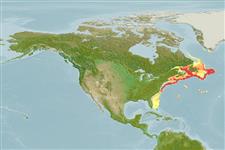>
Gadiformes (Cods) >
Phycidae (Phycid hakes)
Etymology: Phycis: Taken from Greek, phykon = seaweed; because of the habits of this fish that lives hidden among them (Ref. 45335).
More on authors: Goode & Bean.
Environment: milieu / climate zone / depth range / distribution range
Ökologie
seewasser benthopelagisch; standorttreu; tiefenbereich 90 - 1500 m (Ref. 40643), usually 360 - 800 m (Ref. 1371). Temperate; 61°N - 24°N, 81°W - 40°W
Western Atlantic: Canada to straits of Florida, found in the outer continental shelves and slopes, but not abundant to south of Cape Hatteras.
Size / Gewicht / Alter
Maturity: Lm ? range ? - ? cm
Max length : 42.0 cm NG Männchen/unbestimmt; (Ref. 58426)
Rückenflossenstacheln (insgesamt): 0; Afterflossenstacheln 0. Dorsal fin with an extremely elongated ray, its length longer than head length. Longest pelvic-fin ray reaching beyond the posterior end of the anal-fin base. Olive on sides, belly pale; the margins of the dorsal, caudal and anal fins darker.
Epibenthic (Ref. 58426). Minimum depth at 90 m (Ref. 1371). Most abundant between 360 and 800 m. Feeds mostly on crustaceans (especially euphausiids, shrimps and amphipods (Ref. 5951)) but also on mollusks and fishes (Ref. 1371).
Life cycle and mating behavior
Geschlechtsreife | Fortpflanzung | Ablaichen | Eier | Fecundity | Larven
Cohen, D.M., T. Inada, T. Iwamoto and N. Scialabba, 1990. FAO species catalogue. Vol. 10. Gadiform fishes of the world (Order Gadiformes). An annotated and illustrated catalogue of cods, hakes, grenadiers and other gadiform fishes known to date. FAO Fish. Synop. 125(10). Rome: FAO. 442 p. (Ref. 1371)
IUCN Rote Liste Status (Ref. 130435)
Bedrohung für Menschen
Harmless
Nutzung durch Menschen
Fischereien: kommerzielles potential
Mehr Information
ReferenzenAquakulturAquakultur ProfilZuchtlinienGenetikElectrophoresesVererbbarkeitKrankheitenVerarbeitungNutrientsMass conversion
Tools
Zusatzinformationen
Download XML
Internet Quellen
Estimates based on models
Preferred temperature (Ref.
123201): 2.9 - 5.7, mean 4.1 °C (based on 56 cells).
Phylogenetic diversity index (Ref.
82804): PD
50 = 0.6255 [Uniqueness, from 0.5 = low to 2.0 = high].
Bayesian length-weight: a=0.00380 (0.00183 - 0.00790), b=3.12 (2.93 - 3.31), in cm total length, based on LWR estimates for this (Sub)family-body shape (Ref.
93245).
Trophic level (Ref.
69278): 3.2 ±0.0 se; based on diet studies.
Widerstandsfähigkeit (Ref.
120179): niedrig, Verdopplung der Population dauert 4,5 - 14 Jahre. (Preliminary K or Fecundity.).
Fishing Vulnerability (Ref.
59153): Moderate to high vulnerability (55 of 100).
Nutrients (Ref.
124155): Calcium = 23.6 [13.1, 48.0] mg/100g; Iron = 0.285 [0.155, 0.529] mg/100g; Protein = 16.2 [14.8, 17.5] %; Omega3 = 0.397 [0.186, 0.795] g/100g; Selenium = 26.7 [10.9, 61.0] μg/100g; VitaminA = 34.8 [8.2, 147.2] μg/100g; Zinc = 0.635 [0.421, 0.947] mg/100g (wet weight);
